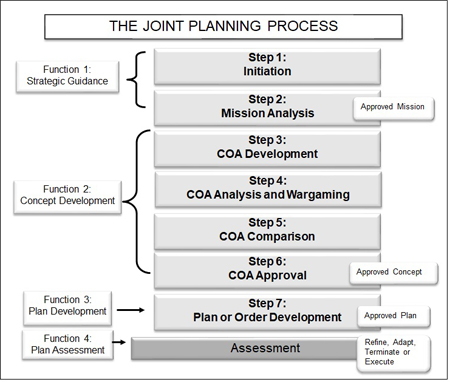The Joint Planning Process (JPP) is an orderly, analytical process, which consists of a set of logical steps to examine a mission; develop, analyze, and compare alternative COAs; select the best COA; and produce a plan or order. The application of operational design as explained in Chapter IV of JP 5-0 provides the conceptual basis for structuring campaigns and operations. JPP provides a proven process to organize the work of the commander, staff, subordinate commanders, and other partners, to develop plans that will appropriately address the problem to be solved. It focuses on defining the military mission and development and synchronization of detailed plans to accomplish that mission. Commanders and staffs can apply the thinking methodology (operational art and design) to discern the correct mission, develop creative and adaptive CONOPS to accomplish the mission, and synchronize those CONOPS so that they can be executed. Together with design, JPP facilitates interaction between the commander, staff, and subordinate and supporting headquarters throughout planning. JPP helps commanders and their staffs organize their planning activities, share a common understanding of the mission and commander’s intent, and develop effective plans and orders.

The figure above shows the seven steps and the four functions of the JPP.
The first two JPP steps (planning initiation and mission analysis) take place during the Strategic Guidance planning function. The next four JPP steps (COA development, COA analysis and wargaming, COA comparison, and COA approval) align under the Concept Development planning function. The final JPP step (plan or order development) occurs during the Plan Development planning function. While there is no JPP step associated with the Plan Assessment planning function, plans and orders are assessed with the RATE methodology in mind.
• Function I – Strategic Guidance consists of two steps: 1-Planning Initiation and 2-Mission Analysis.
• Function II – Concept Development consists of four steps: 3-COA Development, 4-COA Analysis and Wargaming, 5-COA Comparison and 6-COA Approval.
• Function III – Plan Development consists of 7-Plan or Order Development.
• Function IV – Plan Assessment. While there is no JPP step associated with the APEX plan assessment planning function, plans and orders are assessed with refine, adapt, terminate, execute (RATE) methodology in mind.
JPP underpins planning at all levels and for missions across the full range of military operations. It applies to both supported and supporting CCDRs and to joint force component commands when the components participate in joint planning. This process is designed to facilitate interaction between the CCDR, staff, and subordinate headquarters throughout planning. JPP helps CCDRs and their staffs organize their planning activities, share a common understanding of the mission and CCDR’s intent, and develop effective plans and orders.
JPP is applicable for all planning. Like operational design, it is a logical process to approach a problem and determine a solution. It is a tool to be used by planners but is not prescriptive. Based on the nature of the problem, other tools available to the planner, expertise in the planning team, time, and other considerations, the process can be modified as required. Similarly, some JPP steps or tasks may be performed concurrently, truncated, or modified as necessary dependent upon the situation, subject, or time constraints of the planning effort. For example, force planning, as an element of plan development, is different for campaign planning and contingency planning.
In a crisis, the steps of JPP may be conducted simultaneously to speed the process.Supporting commands and organizations often conduct JPP simultaneously and iteratively with the supported CCMD. In these cases, once mission analysis begins it continues until the operation is complete. Moreover, steps 4-7 are repeated as often as necessary to integrate new requirements (missions) into the development of the plan.
 This article is an extract from "Joint/Interagency SMARTbook 1 – Joint Strategic & Operational Planning, 3rd Ed. (Planning for Planners (JIA1-3 / Third Edition))" by The Lightning Press. Download a free PDF sample and learn more at: Joint/Interagency SMARTbook 1 – Joint Strategic & Operational Planning, 3rd Ed. (Planning for Planners (JIA1-3 / Third Edition)).
This article is an extract from "Joint/Interagency SMARTbook 1 – Joint Strategic & Operational Planning, 3rd Ed. (Planning for Planners (JIA1-3 / Third Edition))" by The Lightning Press. Download a free PDF sample and learn more at: Joint/Interagency SMARTbook 1 – Joint Strategic & Operational Planning, 3rd Ed. (Planning for Planners (JIA1-3 / Third Edition)).
Browse additional military doctrine articles in our SMARTnews Blog & Resource Center.
About The Lightning Press SMARTbooks. Recognized as a “whole of government” doctrinal reference standard by military, national security and government professionals around the world, SMARTbooks comprise a comprehensive professional library. SMARTbooks can be used as quick reference guides during operations, as study guides at education and professional development courses, and as lesson plans and checklists in support of training. Browse our collection of Military Reference SMARTbooks to learn more.













































